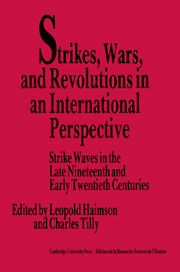 Strikes, Wars, and Revolutions in an International Perspective
Strikes, Wars, and Revolutions in an International Perspective Book contents
- Frontmatter
- Contents
- List of contributors
- Preface
- Part I Introductions
- Part II Models and realities
- 3 Introduction
- 4 Changing forms of labor conflict: secular development or strike waves?
- 5 Strikes and power in Britain, 1870–1920
- 6 Two strike waves in Imperial Russia, 1905–1907, 1912–1914
- 7 Strikers in revolution: Russia, 1917
- 8 Strikes in Imperial Russia, 1895–1913: a quantitative analysis
- 9 Labor conflicts in Italy before the rise of fascism, 1881–1923: a quantitative analysis
- 10 Strikes and politics in the United States, 1900–1919
- Part III Workers in metal-processing enterprises in comparative perspective
- Part IV The effects of short-term variation
- Part V Conclusion
7 - Strikers in revolution: Russia, 1917
Published online by Cambridge University Press: 25 March 2010
- Frontmatter
- Contents
- List of contributors
- Preface
- Part I Introductions
- Part II Models and realities
- 3 Introduction
- 4 Changing forms of labor conflict: secular development or strike waves?
- 5 Strikes and power in Britain, 1870–1920
- 6 Two strike waves in Imperial Russia, 1905–1907, 1912–1914
- 7 Strikers in revolution: Russia, 1917
- 8 Strikes in Imperial Russia, 1895–1913: a quantitative analysis
- 9 Labor conflicts in Italy before the rise of fascism, 1881–1923: a quantitative analysis
- 10 Strikes and politics in the United States, 1900–1919
- Part III Workers in metal-processing enterprises in comparative perspective
- Part IV The effects of short-term variation
- Part V Conclusion
Summary
Conceptualization
A comprehensive analysis of the strike movement in Russia during 1917 must have two distinct but related objectives. It must attempt to understand the strike process as a specific aspect of the broader patterns of Russian labor activism, relating such elements as the scope, intensity, duration, and outcome of strikes to the general social history of Russian workers; and it must also be an investigation of the ways in which elements common to the strike process generally, in Russia and elsewhere, both affected and were affected by the particular elements of the Russian revolutionary conjuncture. As such, a study of strikes in 1917 contrasts both to “longitudinal” studies, which analyze strikes over substantial periods of time, and to episodic studies, which look in detail at, say, the American Pullman strike of 1894 or the British general strike of 1926. An investigation such as ours is, in effect, a crosssectional analysis of what amounts to a single strike wave, but one that has as its primary focus not so much the strike wave itself, as the interrelationships between this particular form of labor protest and the historical context in which it occurs.
For the comparative purposes of this volume, however, we minimize our attention in this paper to Russia's historical context, although that is the primary focus of our larger work. Our goal is to describe the role in Russia during 1917 of several factors that other studies in this volume have found to be important, and to make available the general results of our statistical analysis.
- Type
- Chapter
- Information
- Strikes, Wars, and Revolutions in an International PerspectiveStrike Waves in the Late Nineteenth and Early Twentieth Centuries, pp. 167 - 196Publisher: Cambridge University PressPrint publication year: 1989
- 2
- Cited by


